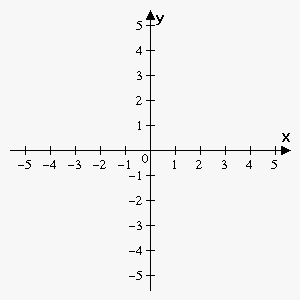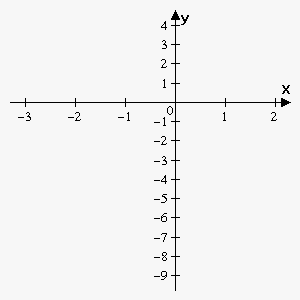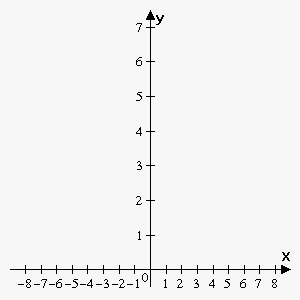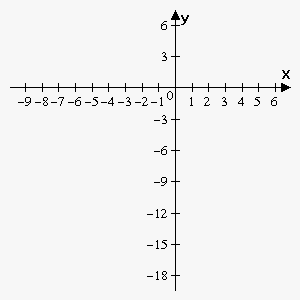Steps for Sketching the Graph of the Function
Suppose we are given continuous on $$${\left[{a},{b}\right]}$$$ function $$$y={f{{\left({x}\right)}}}$$$ that is twice differentiable, except points where the derivative $$$f{'}\left({x}\right)$$$ doesn't exist or has infinite value.
To sketch the graph of a function, we need to perform the following:
- Determine, whether function is obtained by transforming a simpler function, and perform necessary steps for this simpler function.
- Determine, whether function is even, odd or periodic. This allows to draw graph of the function on some subinterval and then just reflect the result.
- Find y-intercept (point $$${f{{\left({0}\right)}}}$$$).
- Find x-intercepts (points where $$${f{{\left({x}\right)}}}={0}$$$).
- Find what asymptotes does function have, if any.
- Calculate first derivative and find points where $$${f{'}}{\left({x}\right)}={0}$$$ or $$${f{'}}{\left({x}\right)}$$$ doesn't exist, in other words find stationary points.
- Use a test (the first derivative or the second derivative) to classify stationary points.
- Find intervals where the function is increasing $$$\left({f{'}}{\left({x}\right)}>{0}\right)$$$ and where it is decreasing $$$\left({f{'}}{\left({x}\right)}<{0}\right)$$$.
- Find points where $$${f{''}}{\left({x}\right)}={0}$$$ or $$${f{''}}{\left({x}\right)}$$$ doesn't exist and test whether these points are points of inflection.
- Find where function is concave up $$$\left({f{''}}{\left({x}\right)}>{0}\right)$$$ and where it is concave down $$$\left({f{''}}{\left({x}\right)}<{0}\right)$$$.
- After you've found "important" points calculate corresponding values of function at these points.
- Add "control" points (some arbitrary points), if needed.
- Draw "important" and "control" points and connect them by lines taking into account found behavior of the function.
- If function is even, odd or periodic then perform corresponding reflection.
- If function is obtained by transforming simpler function, perform corresponding shift, compressing/stretching.
It is often convenient to draw all points, you've found, in the table.
Example 1. Sketch graph of the function $$${f{{\left({x}\right)}}}=\frac{{1}}{{{x}-{1}}}$$$.
Since $$${f{{\left({x}\right)}}}={g{{\left({x}-{1}\right)}}}$$$ where $$${g{{\left({x}\right)}}}=\frac{{1}}{{x}}$$$ then we study function $$${g{{\left({x}\right)}}}=\frac{{1}}{{x}}$$$ and then shift graph one unit to the right.
Function is odd because $$${g{{\left({x}\right)}}}=-{g{{\left(-{x}\right)}}}$$$, so we consider only interval $$${\left[{0},\infty\right)}$$$ and then just reflect result about the origin. Function is not periodic.
There is no y-intercept because $$${g{{\left({0}\right)}}}$$$ is undefined.
There is no x-intercept because there are no points where $$${g{{\left({x}\right)}}}=\frac{{1}}{{x}}={0}$$$.
Since $$$\lim_{{{x}\to{{0}}^{+}}}\frac{{1}}{{x}}=+\infty$$$ then $$${x}={0}$$$ is vertical asymptote.
Since $$$\lim_{{{x}\to\infty}}\frac{{1}}{{x}}={0}$$$ then $$${y}={0}$$$ is horizontal asymptote.
We have that $$${g{'}}{\left({x}\right)}=-\frac{{1}}{{{x}}^{{2}}}$$$. There are no points where derivative equals 0. Point $$${x}={0}$$$ is where derivative doesn't exist.
Since $$${g{'}}{\left({x}\right)}=-\frac{{1}}{{{x}}^{{2}}}<{0}$$$ for all $$${x}$$$ then function is decreasing on $$${\left({0},+\infty\right)}$$$ and there are no extrema according to First Derivative Test.
Second derivative is $$${g{''}}{\left({x}\right)}=\frac{{2}}{{{x}}^{{3}}}$$$. There are no points where $$${g{''}}{\left({x}\right)}={0}$$$ and second derivative doesn't exist when $$${x}={0}$$$.
Since second derivative is positive for $$${x}>{0}$$$ then function is concave upward on $$${\left({0},\infty\right)}$$$.
Point $$${x}={0}$$$ is not point of inflection because $$${x}={0}$$$ is not in the domain of the function.
So, we actually don't have important points, but when $$${x}$$$ approaches 0 from the right function grows without a bound and we can sketch function, taking into account that functions is decreasing and concave upward on $$${\left({0},+\infty\right)}$$$. For better graph take a couple of control points: $$${\left({1},{1}\right)},{\left({1},\frac{{1}}{{2}}\right)},{\left({4},\frac{{1}}{{4}}\right)}$$$.
Since function is odd, reflect it about origin.
Shift the function 1 unit to the right.
Example 2. Sketch graph of the function $$${f{{\left({x}\right)}}}={{\left({x}+{2}\right)}}^{{2}}{{\left({x}-{1}\right)}}^{{3}}$$$.
There is no simpler function that initial function is obtained from.
Function is neither even nor odd and not periodic.
$$${f{{\left({0}\right)}}}={{\left({0}+{2}\right)}}^{{2}}{{\left({0}-{1}\right)}}^{{3}}=-{4}$$$, so y-intercept is -4.
x-intercepts are points where $$${f{{\left({x}\right)}}}={0}$$$: $$${{\left({x}+{2}\right)}}^{{2}}{{\left({x}-{1}\right)}}^{{3}}={0}$$$ which gives $$${x}=-{2}$$$ and $$${x}={1}$$$.
Since function is continuous everywhere, $$$\lim_{{{x}\to-\infty}}{f{{\left({x}\right)}}}=-\infty$$$ and $$$\lim_{{{x}\to\infty}}{f{{\left({x}\right)}}}=\infty$$$ then there are no asymptotes.
We have that $$${f{'}}{\left({x}\right)}={2}{\left({x}+{2}\right)}{{\left({x}-{1}\right)}}^{{3}}+{3}{{\left({x}+{2}\right)}}^{{2}}{{\left({x}-{1}\right)}}^{{2}}={\left({x}+{2}\right)}{{\left({x}-{1}\right)}}^{{2}}{\left({2}{x}-{2}+{3}{x}+{6}\right)}=$$$
$$$={\left({x}+{2}\right)}{{\left({x}-{1}\right)}}^{{2}}{\left({5}{x}+{4}\right)}$$$.
So, derivative equals 0 when $$${x}=-{2},{x}={1},{x}=-\frac{{4}}{{5}}$$$.
According to method of intervals number line is divided by stationary points on four intervals.
First interval is $$${\left(-\infty,-{2}\right)}$$$: taking any point from this interval, for example $$${x}=-{3}$$$ we obtain that $$${f{'}}{\left(-{3}\right)}={\left(-{3}+{2}\right)}{{\left(-{3}-{1}\right)}}^{{2}}{\left({5}\cdot{\left(-{3}\right)}+{4}\right)}>{0}$$$, so $$${f{'}}{\left({x}\right)}>{0}$$$ on this interval.
Second interval is $$${\left(-{2},-\frac{{4}}{{5}}\right)}$$$: taking any point from this interval, for example $$${x}=-{1}$$$ we obtain that $$${f{'}}{\left(-{1}\right)}={\left(-{1}+{2}\right)}{{\left(-{1}-{1}\right)}}^{{2}}{\left({5}\cdot{\left(-{1}\right)}+{4}\right)}<{0}$$$, so $$${f{'}}{\left({x}\right)}<{0}$$$ on this interval.
Third interval is $$${\left(-\frac{{4}}{{5}},{1}\right)}$$$: taking any point from this interval, for example $$${x}={0}$$$ we obtain that $$${f{'}}{\left({0}\right)}={\left({0}+{2}\right)}{{\left({0}-{1}\right)}}^{{2}}{\left({5}\cdot{\left({0}\right)}+{4}\right)}>{0}$$$, so $$${f{'}}{\left({x}\right)}>{0}$$$ on this interval.
Fourth interval is $$${\left({1},\infty\right)}$$$: taking any point from this interval, for example $$${x}={3}$$$ we obtain that $$${f{'}}{\left({3}\right)}={\left({3}+{2}\right)}{{\left({3}-{1}\right)}}^{{2}}{\left({5}\cdot{3}+{4}\right)}>{0}$$$, so $$${f{'}}{\left({x}\right)}>{0}$$$ on this interval.
According to First Derivative Test $$${x}=-{2}$$$ is local maximum, $$${x}=-\frac{{4}}{{5}}$$$ is local minimum and $$${x}={1}$$$ is not an extremum.
Second derivative is $$${f{''}}{\left({x}\right)}={2}{\left({x}-{1}\right)}{\left({10}{{x}}^{{2}}+{16}{x}+{1}\right)}$$$.
Roots of the equation $$${10}{{x}}^{{2}}+{16}{x}+{1}={0}$$$ are $$${x}=\frac{{-{8}+{3}\sqrt{{{6}}}}}{{10}}\approx-{0.065}$$$ and $$${x}=\frac{{-{8}-{3}\sqrt{{{6}}}}}{{10}}\approx-{1.535}$$$.
So, points where second derivative equals 0 are $$${x}={1},{x}=-{0.065},{x}=-{1.535}$$$.
Clearly they are all points of inflections because second derivative changes sign at these points.
$$${f{''}}{\left({x}\right)}>{0}$$$ on $$${\left(-{1.535},-{0.065}\right)}\cup{\left({1},\infty\right)}$$$ and $$${f{''}}{\left({x}\right)}<{0}$$$ on $$${\left(-\infty,-{1.535}\right)}\cup{\left(-{0.0065},{1}\right)}$$$.
So we have following "important" points:
| $$${x}$$$ | -2 | -1.535 | $$$-\frac{{4}}{{5}}$$$ | -0.065 | 0 | 1 |
| $$${f{{\left({x}\right)}}}$$$ | 0 | -3.52241 | -8.3981 | -4.052 | -4 | 0 |
| type | maximum, x-intercept | inflection | minimum | inflection | y-intercept | inflection, x-intercept |
Function is increasing on $$${\left(-\infty,-{2}\right)}\cup{\left(-\frac{{4}}{{5}},\infty\right)}$$$ and decreasing on $$${\left(-{2},-\frac{{4}}{{5}}\right)}$$$.
Function is concave upward on $$${\left(-{1.535},-{0.065}\right)}\cup{\left({1},\infty\right)}$$$ and concave downward on $$${\left(-\infty,-{1.535}\right)}\cup{\left(-{0.0065},{1}\right)}$$$.
Note that points $$${\left(-{0.065},-{4.052}\right)}$$$ and $$${\left({0},-{4}\right)}$$$ are very close, so they are almost indistinguishable on graph.
Example 3. Sketch graph of the function $$${f{{\left({x}\right)}}}=\frac{{{{x}}^{{2}}-{5}{x}+{6}}}{{{{x}}^{{2}}+{1}}}$$$.
There is no simpler function that initial function is obtained from.
Function is neither even nor odd and not periodic.
$$${f{{\left({0}\right)}}}=\frac{{{{0}}^{{2}}-{5}\cdot{0}+{6}}}{{{{0}}^{{2}}+{1}}}={6}$$$, so y-intercept is 6.
x-intercepts are points where $$${f{{\left({x}\right)}}}={0}$$$: $$${\left({{x}}^{{2}}-{5}{x}+{6}\right)}={\left({x}-{2}\right)}{\left({x}-{3}\right)}={0}$$$ which gives $$${x}={2}$$$ and $$${x}={3}$$$.
Since function is continuous everywhere, $$$\lim_{{{x}\to\infty}}\frac{{{{x}}^{{2}}-{5}{x}+{6}}}{{{{x}}^{{2}}+{1}}}={1}$$$ then there is only one asymptote: horizontal asymptote $$${y}={1}$$$.
We have that $$${f{'}}{\left({x}\right)}=\frac{{{\left({{x}}^{{2}}-{5}{x}+{6}\right)}'{\left({{x}}^{{2}}+{1}\right)}-{\left({{x}}^{{2}}-{5}{x}+{6}\right)}{\left({{x}}^{{2}}+{1}\right)}'}}{{{\left({{x}}^{{2}}+{1}\right)}}^{{2}}}={5}\frac{{{{x}}^{{2}}-{2}{x}-{1}}}{{{\left({{x}}^{{2}}+{1}\right)}}^{{2}}}$$$.
Roots of the equation $$${{x}}^{{2}}-{2}{x}-{1}={0}$$$ are $$${x}={1}+\sqrt{{{2}}}\approx{2.41}$$$ and $$${x}={1}-\sqrt{{{2}}}\approx-{0.41}$$$.
So, derivative equals 0 when $$${x}=-{0.41},{x}={2.41}$$$.
According to method of intervals number line is divided by stationary points on three intervals.
First interval is $$${\left(-\infty,-{0.41}\right)}$$$: $$${f{'}}{\left({x}\right)}>{0}$$$ on this interval.
Second interval is $$${\left(-{0.41},{2.41}\right)}$$$:$$${f{'}}{\left({x}\right)}<{0}$$$ on this interval.
Third interval is $$${\left({2.41},\infty\right)}$$$: $$${f{'}}{\left({x}\right)}>{0}$$$ on this interval.
According to First Derivative Test $$${x}=-{0.41}$$$ is local maximum, $$${x}={2.41}$$$ is local minimum.
Second derivative is $$${f{''}}{\left({x}\right)}=-{10}\frac{{{\left({x}+{1}\right)}{\left({{x}}^{{2}}-{4}{x}+{1}\right)}}}{{{\left({{x}}^{{2}}+{1}\right)}}^{{3}}}$$$.
Roots of the equation $$${{x}}^{{2}}-{4}{x}+{1}={0}$$$ are $$${x}={2}-\sqrt{{{3}}}\approx{0.27}$$$ and $$${x}={2}+\sqrt{{{3}}}\approx{3.73}$$$.
So, points where second derivative equals 0 are $$${x}=-{1},{x}={0.27},{x}={3.73}$$$.
Clearly they are all points of inflections because second derivative changes sign at these points.
$$${f{''}}{\left({x}\right)}>{0}$$$ on $$${\left(-\infty,-{1}\right)}\cup{\left({0.27},{3.73}\right)}$$$ and $$${f{''}}{\left({x}\right)}<{0}$$$ on $$${\left(-{1},{0.27}\right)}\cup{\left({3.73},\infty\right)}$$$.
So we have following "important" points:
| $$${x}$$$ | -1 | -0.41 | 0 | 0.27 | 2 | 2.41 | 3 | 3.73 |
| $$${f{{\left({x}\right)}}}$$$ | 6 | 7.0354 | 6 | 4.402 | 0 | -0.0355 | 0 | 0.0847 |
| type | inflection | maximum | y-intercept | inflection | x-intercept | minimum | x-intercept | inflection |
Function is increasing on $$${\left(-\infty,-{0.41}\right)}\cup{\left({2.41},\infty\right)}$$$ and decreasing on $$${\left(-{0.41},{2.41}\right)}$$$.
Function is concave upward on $$${\left(-\infty,-{1}\right)}\cup{\left({0.27},{3.73}\right)}$$$ and concave downward on $$${\left(-{1},{0.27}\right)}\cup{\left({3.73},\infty\right)}$$$.
Horizontal asymptote is $$${y}={1}$$$.
Example 4. Sketch graph of the function $$${f{{\left({x}\right)}}}=\frac{{{\left({x}-{1}\right)}}^{{3}}}{{{\left({x}+{1}\right)}}^{{2}}}$$$.
There is no simpler function that initial function is obtained from.
Function is neither even nor odd and not periodic.
$$${f{{\left({0}\right)}}}=\frac{{{\left({0}-{1}\right)}}^{{3}}}{{{\left({0}+{1}\right)}}^{{2}}}=-{1}$$$, so y-intercept is -1.
x-intercepts are points where $$${f{{\left({x}\right)}}}={0}$$$: $$${{\left({x}-{1}\right)}}^{{3}}={0}$$$ which gives $$${x}={1}$$$.
Vertical asymptote is $$${x}=-{1}$$$ because $$$\lim_{{{x}\to-{{1}}^{+}}}\frac{{{\left({x}-{1}\right)}}^{{3}}}{{{\left({x}+{1}\right)}}^{{2}}}=-\infty$$$.
There are no horizontal asymptotes because $$$\lim_{{{x}\to\infty}}\frac{{{\left({x}-{1}\right)}}^{{3}}}{{{\left({x}+{1}\right)}}^{{2}}}=\infty$$$ and $$$\lim_{{{x}\to-\infty}}\frac{{{\left({x}-{1}\right)}}^{{3}}}{{{\left({x}+{1}\right)}}^{{2}}}=-\infty$$$.
Since $$$\lim_{{{x}\to\infty}}\frac{{{f{{\left({x}\right)}}}}}{{x}}=\lim_{{{x}\to\infty}}\frac{{{{x}}^{{3}}-{3}{{x}}^{{2}}+{3}{x}-{1}}}{{{{x}}^{{3}}+{2}{{x}}^{{2}}+{x}}}={1}$$$ then $$${m}={1}$$$. Now $$$\lim_{{{x}\to\infty}}{\left({f{{\left({x}\right)}}}-{m}{x}\right)}=\frac{{{{x}}^{{3}}-{3}{{x}}^{{2}}+{3}{x}-{1}}}{{{{x}}^{{2}}+{2}{x}+{1}}}-{x}=\lim_{{{x}\to\infty}}\frac{{-{5}{{x}}^{{2}}+{2}{x}-{1}}}{{{{x}}^{{2}}-{2}{x}+{1}}}=-{5}$$$.
So, there is slant asymptote $$${y}={x}-{5}$$$.
We have that $$${f{'}}{\left({x}\right)}=\frac{{{\left({{\left({x}-{1}\right)}}^{{3}}\right)}'{{\left({x}+{1}\right)}}^{{2}}-{{\left({x}-{1}\right)}}^{{3}}{\left({{\left({x}+{1}\right)}}^{{2}}\right)}'}}{{{\left({x}+{1}\right)}}^{{4}}}=\frac{{{{\left({x}-{1}\right)}}^{{2}}{\left({x}+{5}\right)}}}{{{\left({x}+{1}\right)}}^{{3}}}$$$.
Derivative equals 0 when $$${x}={1},{x}=-{5}$$$ and doesn't exist when $$${x}=-{1}$$$.
Since $$${{\left({x}-{1}\right)}}^{{2}}\ge{0}$$$ then these factor doesn't influence sign of derivative.
Thus $$${f{'}}{\left({x}\right)}>{0}$$$ when $$${x}\in{\left(-\infty,-{5}\right)}\cup{\left(-{1},\infty\right)}$$$ and $$${f{'}}{\left({x}\right)}<{0}$$$ when $$${x}\in{\left(-{5},-{1}\right)}$$$.
According to First Derivative Test $$${x}=-{5}$$$ is local maximum and $$${x}={1}$$$ is not an extremum.
Point $$${x}=-{1}$$$ is not in the domain of function, so clearly not an extremum.
Second derivative is $$${f{''}}{\left({x}\right)}={24}\frac{{{x}-{1}}}{{{\left({x}+{1}\right)}}^{{4}}}$$$.
So, point where second derivative equals 0 is $$${x}={1}$$$.
Clearly it is inflection point because second derivative changes sign at this point.
$$${f{''}}{\left({x}\right)}>{0}$$$ when $$${x}>{1}$$$ and $$${f{''}}{\left({x}\right)}<{0}$$$ when $$${x}<{1}$$$.
Let's add a couple of control points:
$$${x}={3}$$$, $$${f{{\left({3}\right)}}}={0.5}$$$.
$$${x}=-{8}$$$, $$${f{{\left(-{8}\right)}}}\approx-{14.88}$$$.
So, we have following points:
| $$${x}$$$ | -8 | -5 | 0 | 1 | 3 |
| $$${f{{\left({x}\right)}}}$$$ | -14.88 | -13.5 | -1 | 0 | 0.5 |
| type | control | maximum | y-intercept | inflection | control |
Function is increasing on $$${\left(-\infty,-{5}\right)}\cup{\left(-{1},\infty\right)}$$$ and decreasing on $$${\left(-{5},-{1}\right)}$$$.
Function is concave upward on $$${\left({1},\infty\right)}$$$ and concave downward on $$${\left(-\infty,{1}\right)}$$$.
Vertical asymptote is $$${x}=-{1}$$$ and slant asymptote is $$${y}={x}-{5}$$$.
